Inter-Region Travel Options in NZ
Executive Summary
There is an increasing general awareness of the negative impacts of CO2 emissions. Roads around Wellington have been blocked by activists indicating that restoring passenger rail services may help address climate change. Details of their proposals and timeframes are lacking. As the goal seems to be reducing travel emissions, it is important to have accurate comparisons showing the alternatives and most importantly when those alternatives can deliver emission reductions.
The analysis below shows that regional passenger train services prior to about 2030, based on the passenger locomotives currently used, have CO2 emissions higher than are available today with electrified road transport or long distance bus services. Also of importance is that the noxious emissions are 20 to 40 times that of modern diesel buses due to the 2-stroke diesel locomotive engines that pre-date any modern emissions standards.
Costs for subsiding rail services can also be high with the Te Huia Hamilton-Auckland example estimated to have a subsidy of about $120 per passenger. While comparisons with road costs are made, the number of people making use of an inter-region road are dramatically higher than are likely to use rail (using the Te Huia example).
If we are prepared to wait until at least 2030 for additional rail solutions, beyond the recently announced Lower North Island upgrade, then lower emissions will be available. The patronage and resulting costs remain an unknown but certainly worth considering and discussing the options. Unfortunately rail has been underfunded and is slow to change, often due to safety considerations.
For those who believe that urgent action is required, then personal choice can make a big difference. For regional travel modes available today, this would include; not flying; using EVs (private, car share or rental); long distance bus; or simply more people in an efficient petrol car.
Inter-region transport options over the next few decades will change, maybe quicker than expected. Electrified aviation will happen and has route and scheduling flexibility that is beyond what rail can offer. Parts of the country like the South Island are unlikely to ever have viable rail electrification. Road transport will always be available and the vehicles we use will be electrified.
Introduction
Disclaimer: I have been an advocate for low emission transport since 2016. The opinions here are my own and not necessarily those of the Better NZ Trust.
There have recently been very visible concerns expressed over climate change via public protest in Wellington under the banner of Restore Passenger Rail.
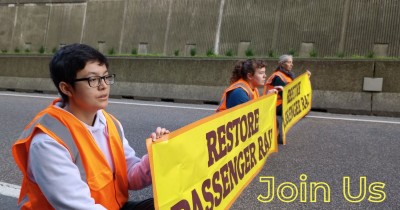
The group is demanding urgent action but their campaign is confusing myself and many others with a poll on Stuff Do you support the Wellington climate protesters? showing 88% opposition to the methods as of 5 May 2023. I can understand the concerns over climate change but how would their campaign reduce emissions to any meaningful extent? What would be achieved and by when?
There is a lot of information being shared on social media about regional transport options but often there no clear indications of realities. There are claims about benefits of the campaign, such as lower emissions, but when the details of achievable timelines and the consequences of acting urgently are checked it becomes obvious that there can be negative net consequences.
A major issue for the campaign is much of New Zealand does not have electrified rail. The current diesel engines used for regional passenger services are nearly 50 years old and 2-stroke with high noxious emissions. Claims are being made that diesel trains have lower emissions than cars but this is a somewhat myopic focus on CO2, not considering other emissions which are very much a human health hazard.
During discussions there are criticisms of EVs as being higher CO2 emissions and not the answer. I have written this blog to outline the options for inter-region travel, the relative emissions, and consideration of when solutions are available.
Key Topics
The common modes of inter-regional travel around NZ, probably in order of number of people carried:
- Private or rental car
- Flying
- Long distance bus
- Rail
Within each mode the power source has a substantial impact on emissions.
Fossil Fuels
- Most private and rental cars as of 2023
- All aircraft, long distance bus and passenger trains
Electrification
- Battery Electric cars
- Battery Electric suburban buses (e.g. 90 in Wellington)
- Direct via wires such as suburban trains
When emissions are mentioned we need to consider both greenhouse gases and noxious emissions that are injurious to human health
CO2 Emissions
- Contribute to global warming
- Currently an almost myopic focus as noxious emissions largely in the past
Noxious Emissions
- Primarily due to burning of fossil fuels
- Prior to modern emission standards the levels were becoming dangerous
- Examples include the DFB locomotive currently used for passenger rail high emissions
- Modern diesel under EURO 5 or later have dramatically lower noxious emissions
Timelines for the reduction of emissions, and who can facilitate meaningful action, are a key discussion item
- Current protests express urgency
- Some solutions for emission reductions available much quicker than others
- Rail upgrades for Lower North Island an example of timelines achievable
- Total emissions across the country matter, not just a niche solution
- The people or agencies who can make changes vary a lot with the proposed solution
Costs relating to some of the current subsidies are very high and with limited funding we need to be careful not to deny support for cost effective methods of reducing emissions.
This blog will consider the above. Other factors like social equity are briefly covered. It is a complex topic so apologies for the amount of information below. I finish at the end with an Appendix that includes discussion of the points in the article Ten popular myths about passenger rail in New Zealand by Suraya Sidhu Singh after it was suggested I write my own blog piece.
Timelines
Different modes can respond to change at different rates. Road and rail upgrades take time. Vehicles may be able to be swapped to use some infrastructure at short notice (e.g. cars or buses on existing roads) while others such as trains requiring direct electrification may have very protracted timelines or never considered viable (e.g. South Island electrification).
The announcement of Funding for new passenger trains celebrated by Greater Wellington and Horizons is good news and highlights the very long life cycles involved with rail transport: "The current fleet of diesel trains are 50 years old and at the end of their working life". That page includes a link to the detailed business plan which lays out a project plan highlighting that from project start it will take about 5 years for the first rolling stock to arrive.
The climate commission report at 2023 Draft advice to inform the strategic direction of the Government’s second emissions reduction plan (April 2023) has a transport section with these key items that relate to inter-regional travel:
- Transport emissions need to decrease rapidly over successive emissions budget periods
- The transport system needs change at all levels to provide New Zealanders with more low emissions options
- The major opportunities to decarbonise by improving emissions efficiency of transport come from replacing fossil-fuelled vehicles with low carbon alternatives
- Decarbonising transport can improve health, wellbeing, and equity
- Decarbonising the light vehicle fleet
- The rapidly climbing share of EVs in vehicles new to Aotearoa New Zealand needs to continue growing throughout the second emissions budget, with sustained support
- Supporting rail and coastal shipping provides resilience to climate impacts [noting only freight focused]
- Aotearoa New Zealand needs to prepare now to enable future decarbonisation of aviation
The concept of Clean Disruption championed by Tony Seba gives some insights into how technology changes typically follow a "S curve", not a straight line. This graphic from Testing Tony Seba’s EV Predictions 2 includes cars and air travel:
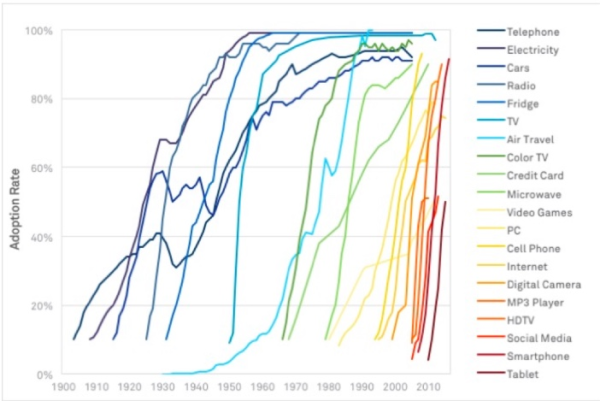
The growth of EVs has started on that S curve. Unfortunately some modes of travel such as rail are bound by physical and financial constraints that make rapid change far more challenging and require longer distance planning.
Aviation is an example which is not constrained by ground infrastructure and recent breakthroughs in battery technology are looking very promising. The announcement The All-New Amprius 500 Wh/kg Battery Platform is Here may seem just like another minor step but is "well positioned to power products in the fast-growing aviation and, eventually, electric vehicles markets". This capacity is over the threshold needed for aviation according to Tesla’s Elon Musk says that batteries enabling electric aircraft are coming in ‘3 to 4 years’ which was stated in 2020. It is hard to not consider this aviation option which could significantly affect where it is appropriate to direct funding and resources.
Long distance bus travel is low emission today and will be lower as longer distance EV solutions become more available. There is route flexibility and easier to schedule without needing to interleave with freight on rail tracks. However, investment is needed in both the hub facilities and the vehicles to make this travel option more appealing.
While some may wish to push all the responsibility onto the "government" and complain when they don't respond with immediate plans to roll out the demanded solution, the reality is that each individual can also make choices that can have a much greater collective impact.
The future options that will provide the best connectivity for the all New Zealanders is by no means clear. What is obvious is that where solutions require long term plans, such as rail, there is a much greater need to pick the right path.
CO2 Emissions
For cars, the emissions from the NZ vehicle fleet have been high by global standards, even exceeding Australia in 2021 based on this graphic from ICCT Australia Path To Zero. The trend line has been enhanced to highlight the NZ aspiration to 2027, hoping to catch up with other countries.
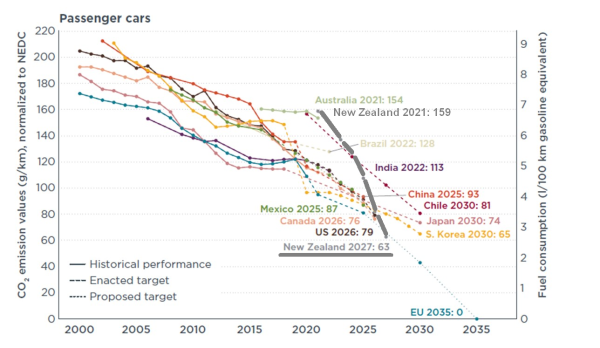
For cars there is now a widening range of emissions from the relatively high “Private car default” which has origins in older cars with large engines, through to hybrid and EVs.
The CO2 emissions from the different modes can be taken from Measuring emissions: A guide for organisations: 2022 detailed guide or from Toitu Travel Emissions Calculator. Some care is needed to apply distance factors, with rail especially disadvantaged where less direct routes are needed.
Obviously if we put more people in any vehicle the emissions per person reduces and for simplicity we can divide by that number ignoring the minor impact of additional weight. For public transport, standard occupancy values are used which are a lot higher for long distance than local.
The following table is for a Wellington-Auckland return trip focusing on CO2 emissions. Flying and the older "Private car default" (using average occupancy of 1.5), have much higher emissions per person than the other options shown.

There has been some criticism that the emissions here are only those generated in NZ and do not include manufacture. If the vehicle has other uses for most of the time, for example the usual family car, then the manufacturing emissions could be allocated to that dominant use. In addition, the other modes shown here are understood to have the same issue. However, to add the manufacturing emissions we can use this ICCT Life Cycle Analysis which has this graphic:
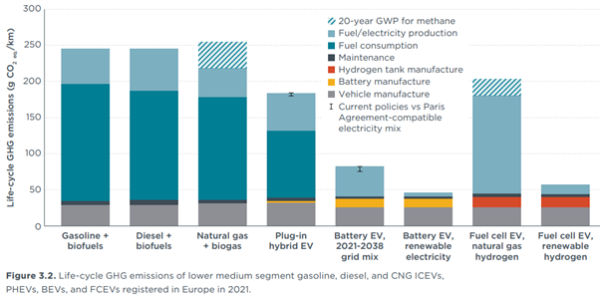
Using the battery and vehicle manufacture portion of about 38g CO2e/km and adding the MBIE large EV rate of 26g CO2e/km gives a total of 64g CO2e/km. This would increase total GHG emissions for 1304 km journey to 83kg CO2e/km or 42kg CO2e/km per person if two in the car, still less than the MBIE train value.
A claim repeated by rail advocates is "Electrified rail is obviously far better, but diesel passenger trains are still lower-emissions than driving even when only a third full. Te Huia, at 236 passengers daily average in September 2022, is over the 200 daily passengers Te Huia needs to break even on emissions". The table above shows how this derivation could be justified but it ignores the fact that "driving" now consists of more EVs on the road. Specifically, there are now probably more people travelling Hamilton to Auckland daily in EVs than there are passengers on Te Huia. With current passenger numbers that would mean the train is significantly worse CO2 than those cars as it is only just less than the "private car default". For the month of February 2023 the Te Huia patronage was under 200 and hence probably even worse than the "private car default".
So we could conclude that flying is bad, driving an older car not much better, and to reduce emissions put more people into an efficient car or take the train or bus.
Noxious Emissions
While we no longer have a strong focus on air quality, the recent report Health impacts of exposure to human-made air pollution highlighted that especially due to pollutants:
- Auckland – 939 premature deaths (age 30+ years) and 4,633 hospitalisations (all ages)
- Christchurch City – 462 premature deaths (age 30+ years) and 1,448 hospitalisations (all ages)
There have been increasingly stringent standards which are applied to NZ vehicles - from European emission standards :
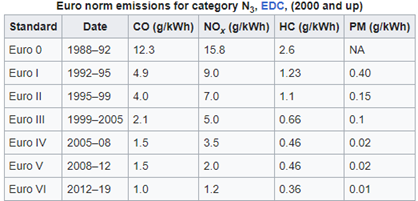
For older vehicles, such as 1970 era diesel locomotives, those standards did not exist. From the report for rail upgrade, where the DFB is currently used by KiwiRail, it was stated these “pre-date any modern emissions standards”. I cannot find any references that suggest emissions upgrades have been applied by KiwiRail. Using the page New Zealand DF class locomotive (1979) it suggests the engine used is a GM 12-645E3C which has what I believe to be a closely related type EMD16-645 E3B in a report Emissions Upgrade Kit Demonstration Project.
The emissions reported from that Australian engine were:
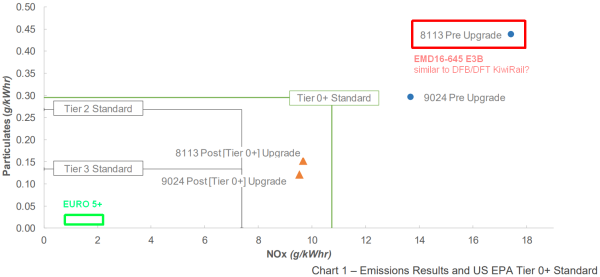
So if these were the emissions from the DFB, they would be 20-40+ times worse than a modern diesel bus.
Assuming that modern long distance coaches are EURO 5 or better, and that the average petrol car emits relatively low noxious emissions, it seems appropriate to say that the current diesel passenger trains such as Te Huia and Capital Connection have substantially higher noxious emissions than the road options.
Newer diesel locomotive engines obviously make a big difference and the order in 2021 for the DM class locomotive should provide much lower emissions for freight in the South Island from about 2026 onwards (understood to be delayed due to COVID).
The Lower North Island upgrade will also deliver much lower rail emissions with the hybrid trains even when running on diesel due to emissions controls. Unfortunately the DFB will be needed until about 2028/2029.
Costs
There have been minimal subsidies for inter-regional travel although Te Huia and the Capital Connection have had public funding. For the Hamilton to Auckland train, the Te Huia Train Viability Report for the Waikato Chamber of Commerce claimed that under a scenario of 72,836 passengers per year that a subsidy of $117.46 per passenger was required. From Te Huia Patronage the sum from April 2022 to March 2023 (12 months) was 68,913 passengers. We also need to note that there have been half price fares active so a subsidy of about $120 per passenger might be valid.
In the article Ten popular myths about passenger rail in New Zealand the author makes claims about the costs of Te Huia relative to road, stating "Passenger rail between Hamilton and Auckland, Te Huia, cost $98 million including operating costs for five years, while the Waikato Expressway, a widened road along the same route, has so far cost over $2 billion. In other words, Te Huia cost 5% of its road equivalent.". I will address this article separately at the end of this blog but the fallacy with this statement is it does not consider the number of people served. There are at least 20,000 vehicles per day on the expressway, probably with an average of 1.5 occupants so Te Huia carries about 0.6% of the people for 5% of the cost.
If subsidies are being considered, we could use the Te Huia example where about 160 EV cars (carrying an average of 1.5 people) would be carrying the same as Te Huia per day. If the full original subsidy of $8,625 were used on every car that would be a total of $1.38 million or 1.4% of the cost of Te Huia with the lower emission benefits extended to much greater distance travelled per person.
Electrification costs can be substantial. The initial case for faster trains between Auckland and Hamilton had a minimum cost of $2.2 billion with some uncertainty about travel times when interacting with the suburban network.
There are are valid arguments for investing in public transport but they need to deliver appropriate social or environmental outcomes.
Rail Interest Groups
There have recently been significant protests in Wellington by the group RESTORE PASSENGER RAIL who have these demands:
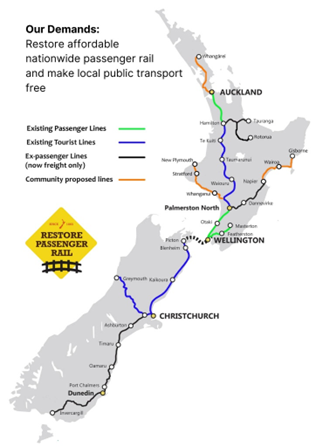
Their campaign is listed as part of the A22 Network which has included in the declaration "We are here to force governments to slash carbon emissions, nothing less. We are here for action, not words. We have a plan.". For me, it remains very unclear whether the plan is to use existing diesel locomotives with the resulting high emissions or wait until maybe 2030 for lower emission options.
Another group is Save Our Trains who link to a conference Future Is Rail Conference - Reconnecting Aotearoa 2030 which has a defined target date. The conference website also mentions Long distance coach travel in Aotearoa New Zealand
Brief Conclusion
Emissions reduction for inter-regional travel is already underway with the move to more efficient road transport. EVs are likely to be one of the lowest emission options providing connections wherever there are roads. However, the rate of change is slow, especially with the propensity for purchasing large diesel SUVs as the family car. Rental EV options are now available. Car share (maybe subsidised) could be an option for those who cannot afford another car.
Rail options need to be debated to ensure that we achieve emissions reductions without excessive costs in a timely manner. Inter-regional bus has the ability to deliver low cost (maybe subsidised) travel to many locations in the near future.
For the same timeframe as adding regional passenger rail services (e.g. 2030+), it is quite possible that regional electrified aviation will offer an alternative that is no more expensive to subsidise than the funding required for rail. Direct routes, especially between islands, with short travel times will always have an appeal for those not on holiday.
An activist group proposing a solution that someone else has to implement, at some undefined point in the future, for questionable benefits, is giving the wrong message. The most important part is how many individuals can each make a difference by their own choices and support public transport options that make sense.
Appendix
Ten popular myths about passenger rail in New Zealand
It was suggested by Suraya Sidhu Singh that if I wished to debate any of the points in Ten popular myths about passenger rail in New Zealand that I should write my own blog so here are my opinions:
1. Our population is too small for passenger rail
While there is population demand between the larger centres, it is not clear at all what frequency and size of train would be appropriate. With newer generation lower emission options this may be more viable but the current rolling stock approach, using heavy diesel locomotive and equally heavy carriages is unlikely to provide an appropriate solution in the short term.
2. Our population density is too low for passenger rail (or, we’re too ‘spread out’)
The countries referenced like Norway and Finland have a larger European tourist population to support the long distance services. In NZ we love our cars which provide flexibility at each end of the journey. Surveys are needed to confirm the patronage to avoid subsidy levels such as for Te Huia ($120 per person).
3. We can’t afford passenger rail
The example used of Te Huia costing only 5% of the expressway is very misleading. It only carries about 0.6% of the people using the expressway. Money can be found if there is a viable business case as for Lower North Island but a lot more discussion needed to validate any others.
4. Buses can do everything trains can do, and more
I agree trains are more popular but who is going to pay for that extra comfort. The greater capacity relative to emissions is not proven when comparing to long distance coach. As for rail offering an alternative route, it is a single path shared with freight that is vulnerable to slips and derailments. Buses can use detours on the roads.
5. New Zealand has earthquakes so we can’t have passenger rail
I agree this is false. However, the time to repair can be very high as for Kaikoura which completely stopped rail travel for a very extended period while road transport had another option.
6. It’s too hilly here for passenger rail
I agree this is false but does add distance and slow down the trains. It would be great if we could get passenger trains running on the electrified lines through the central North Island
7. We have ‘narrow gauge’ rail, which will always be too slow for passengers
I agree not true. However, the single tracks and limited passing loops add scheduling challenges and delays waiting for freight can be experienced
8. We love our cars too much
This is not a myth. We love our cars because of the extent of mobility they offer for regional travel. There is a group that does not like cars or able to own one and they need public transport options like buses or car share for best national coverage. The substantial majority of the population want road transport connections available as their first priority.
9. Passenger rail stopped because people stopped wanting to use it
The regional train in 2000 like lower South Island did not have sufficient patronage to sustain the service. If anything closer to the real cost (e.g. Te Huia at $130 per passenger) was charged then patronage would cease. The government (local and central) will continue to subsidise service like the Capital Connection. There is a risk that some service might encourage long distance commuting which is not a sensible environmental outcome - may look good for patronage but still consuming resources.
10. Driving produces fewer emissions than diesel trains
This is the most dangerous claim as it gets adopted by those passionate about climate change. As discussed above under emissions, while the CO2 might be lower, we cannot be so myopic that we ignore the high levels of noxious emissions from the current 2-stroke diesel engines. Provided this claim is tagged with the caveat of "future low emissions locomotives" then it is more plausible but if it is applied to regional passenger rail in NZ in 2023 (or even up to 2028) it is very misleading and just wrong.
How to bring back passenger trains
Another recent item is How to bring back passenger trains that contains some items I wish to review:
1. Trains are far lower emission than cars, and always will be
Some relatively high values are used for EV emissions which date from a 2015 report and I have added different sources above. The diesel rail emissions are merged with the electrified values. The data included in this MBIE 2022 table splits out for diesel which is the most relevant for the subject of inter-regional rail:
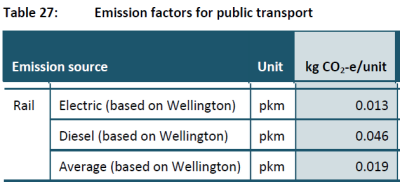
While we can debate whether this diesel value is higher or lower than the CO2 for an EV, the important point of the noxious emissions has been completely overlooked. As the Capital Connection and Wairarapa trains travel through significant suburbia (Porirua/Tawa and entire Hutt Valley) this is is very relevant and current diesel trains are not lower emissions than cars
2. I see first hand how even a second-rate train, the Capital Connection – slow, rattly, unsubsidised, and infrequent – can survive and even be filled day after day
It is difficult to find the level of subsidy as the information is often redacted. However, Ministerial Briefing - NZ UPGRADE PROGRAMME – CAPITAL CONNECTION UPDATE had these items:


It is not known if this latter item was approved but as the new trains are not due until at least 2028 it gives an indication of some of the costs of delivering rail services. If we assume 5 years of use that is $3m per year which for 112,000 passengers is a subsidy of $26 per passenger. In addition there are currently half priced fares.
It will be necessary to subsidise public transport - discussions are needed about appropriate funding and myths dispelled that they can operate without subsidy if we want high patronage.